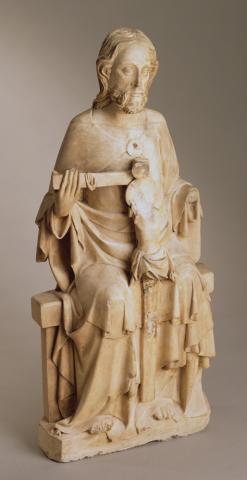The Holy Trinity | Throne of Grace
The Holy Trinity | Throne of Grace
French, ca. 1300-1350
Early Renaissance
marble
height 72.4 cm
width 34.3 cm
Portland Art Museum, 61.52
Gift of the Samuel H. Kress Foundation
Dave Roletto, Medieval Portland Capstone Student, Winter 2005
The statue, rendering the Christian motif of the Throne of Grace, is made of marble. The statue portrays the figure of God sitting on his throne in heaven. The throne resembles a backless bench. The figure of God is stately, dressed in robes, and has long wavy hair on his head and a long flowing beard. His eyes are blank and stare straight ahead. When the statue was first created, the figure of God on the throne held a cross in front of him with each hand supporting one side. The cross extended from the level of his forehead to his feet. On the cross was the figure of Jesus, with his hands nailed to the cross. We see the moment just after Crucifixion.
The statue has sustained damage over time. Only the chest, waist, and legs remain of the of Jesus' figure. His right hand is still attached to part of the cross but his left hand and both of his arms are missing. The dove that represents the Holy Spirit is also missing from above Jesus' head. Likewise, the figure of God has lost its toe, in addition to minor damage to other parts of the statue.
The image of the Throne of Grace is also known as the Trinity in some countries and is a common image in the Middle Ages. It represents God the Father, together with the Holy Spirit in the form of a white dove, gathering up the body of Christ and raising it heavenward. There are two variations: God the Father either supports Christ, who is still nailed to the cross, or God is simply holding up the lifeless body in his lap.
Several theological ideas converge in the image: God the Father has accepted his son's sacrifice, he has received once more into his glory the son who died on the Cross for humanity, and he shows him to humanity as the means of atonement by which they will be redeemed. Very similar free-standing sculptures of the Throne of Grace can be found in better condition in the following locations: Dominican Priory, Kilkenny (Ireland) University Museum of National Antiquities, Oslo (Norway), and the Museum of Fine Arts, Boston (USA).
Dave Roletto, Medieval Portland Capstone Student, Winter 2005
Background Essay: Marble and Masons in Medieval France
During the fourteenth century, marble was an expensive material. Its price varied according to the conditions of quarrying, of transportation and the use to which it was put. It was more often used In Italy during the fourteenth century, as it had been throughout the Middle Ages, for there it was found in abundance. Quarries like those of Carrara were continuously worked, but many antique marbles were utilized and carved over again. Ancient columns, for example, served for the carving of statues, and sometimes plaques were turned from back to front and given new inscriptions. In other regions where the preference for marble persisted, patrons were limited by its rarity from the slowing in quarrying. Other materials with a polish close to that of marble were then sometimes employed.
In France, where marble was in some regions used during the Romanesque period, it became rare during the thirteenth century, and quarrying was then limited exclusively to the Mediterranean Languedoc, Roussillon, and the Alps. It has been observed that the major works of thirteenth-century sculpture in northern France were linked to the production of a luxury statuary in royal or aristocratic households as well as for churches.
As a result of the loss of their polychrome, nearly all medieval sculptures differ radically today from their original appearance. Polychromy is the use of many colors in the decoration, especially in architecture and sculpture. The majority of stone sculptures have been stripped of their painted decoration and because of this, the modern observer can gain only a limited impression of how they must have looked. Marble and alabaster figures and reliefs were sometimes left unpainted before 1500 in northern Europe, as the natural color of the material appealed more than the rougher-grained stones. This may be the case for the Throne of Grace statue.
It is doubtful whether the 'sculptor' as we know him today, existed in the medieval period. From the twelfth century through the sixteenth there seems to have been an interchangeability between stone cutters, stone masons, and image carvers, and in contemporary documents it is not always possible to be exactly sure what a craftsman was being paid for by the description applied to him.
The medieval mason was not a monk but a highly skilled lay craftsman who combined the roles of architect, builder, designer, and engineer. Unfortunately, there are no medieval manuals of stone-carving to give a clear idea of how the mason was trained, but it is likely that the block of stone would have been marked with the outline of the figure to be carved, and that the sculptor would have worked straight onto the block without the benefit of a sketch model, as became the norm at a later date. Some people believed that medieval masons had some magical secret but this was actually just an understanding of proportion and basic geometry.
Tools of the time included a wide range of options including chisels, files, and drills. Each of these left different marks on the surface of medieval sculptures and has given us a chance to identify some of the methods used in their works of art.

